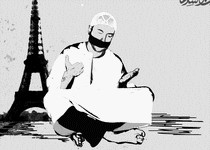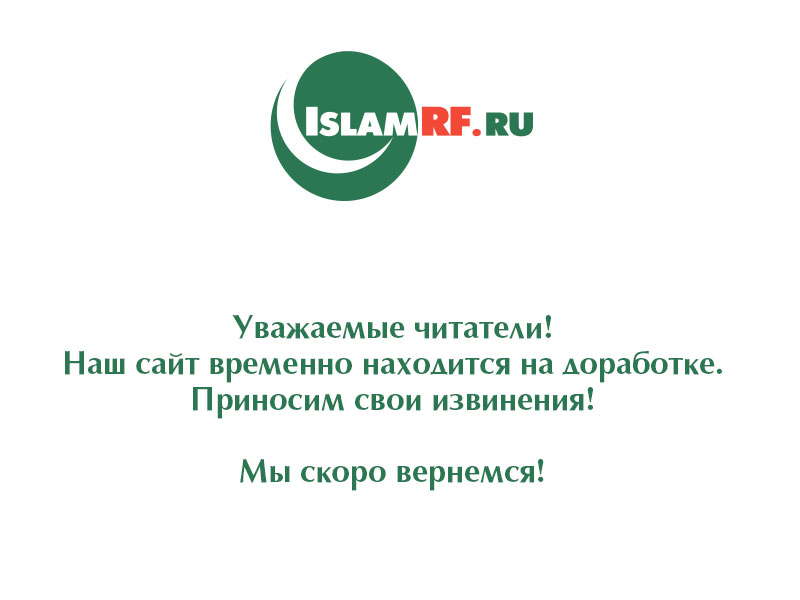Islam and Europe
16.12.2008 12:09
East and West. Islam and Christianity. These cultural-historic concepts reflect our thinking stereotypes. During the centuries in Western Europe Islam has been labeled as an aggressive and highly hostile religion of the “infidels”. Is such a narrow and highly unjust approach still actual nowadays or is it not? The thing is that this statement based on idea of immanent incompatibility of the Muslim and European modes of culture is quite viable and strongly supported by a number of high-ranking officials and other activists in European countries, opposing religious radicalism yet feeling a pathological hatred toward Islam.
East has been a pleasant dream for European travelers and different kind of researchers for ages due to its purely refine, rich and delicate essence and capturing unveiled mystery. Its amazing Scheherazade’s “Thousand and One Nights” fairy tales collection woke up one’s insight and brought their imagination in the very depth of centuries and in the astonishing and enchanting world of Eastern beauty and Arabic cities emerging from gracious and still deserts. The whole range of the East-originating goods such as fabrics, spices and fragrances was extremely precious which made people pay a lot to acquire them. That’s why rare and outlandish stuff was traditionally referred to as “arabesque”.
Today we capable to realize what immense contribution culture of the Middle Eastern nations has made to the process of establishment and development of the European civilization, eliminating an array of cultural gaps. To be more exact, the role of so-called cultural and intellectual agent was adopted by the Arab-Muslim world back in the Middle Ages. And history of these inter-civilization contacts within the Mediterranean area can only be apprehended through the permanent interaction which finally resulted in stable spiritual unity. Influence asserted by Islam on processes within Europe in the Middle Ages was quite multilateral, encompassing politics, economy, philosophy, socio-cultural and commercial issues, even routine day life. In addition, today Islam keeps on posing a great number of things to discuss. Such as its correlation with the process of feudal system genesis researched by Perrin, a Belgian historian. Also it sparked fervent debates over origin of the “fablio” genre and coexistence of the eastern and western elements in the Provancial lyrics as well as Islamic influence on Dante’s work. In natural science it primarily concerned usage of great Arabic experience in medicine and astronomy. While in philosophy it referred to profound scientific legacy of Ibn Sina who influenced a lot Saint Augustin followers’ of the late Middle Ages deriving numerous specific concepts such as “attribute”.
It seems vital to realize the fact that Islamic expansion in North Africa, Egypt and Syria was accompanied by deprivation of almost half of Christian territories in the Mediterranean and Muslim conquest of Spain and Sicily were largely regarded as a direct aggression and waging a war in the name of faith. No need to say what place in public esteem was occupied by crusades in Palestine, Christian occupation of Jerusalem with the following Salah ad-Din’s revenge, Uthman-Turkish intrusion in the Balkan Peninsular and insurrection of the Greek and Slavic population. That is how the stereotype of endless and bitter fighting between Christians and Muslims deeply rooted in the historical background was launched.
Despite occasional bursts of religious xenophobia among population, European both religious and cultural elite was petty well aware of necessity of spiritual and material values exchange in everything concerning Arabic science and culture, and thus working out a respectful approach towards so-called “hostile” Muslim civilization. Even though derivations held additional and non-fundamental character, Europe tended to absorb and integrate primarily the elements of Arabic antique thought and science which were not initially characteristic to its religious or cultural tradition. And the case is that Islam not just enriched European science and humanities, but basically made a palpable contribution to the process of European self-image and self-consciousness formation as well as greatly predetermined the cultural background.
Having conquered Spain and Sicily, Arabs attracted much attention to themselves. However, their intrusion initially seemed to be comparable to mere barbaric attack. For instance, the Venerable Bede’s “Ecclesiastical History of the English People” mentions about an awful punishment for Gallia embodied in Saracens. By the way the word “Saracen” originates from the Greek language as a synonym for “Arabs”.
“Royal Annals” describe the Saxon insurgency and the Saracen invasion of Septimania in 793 as the most grave trials for the Christian population. Then in 854 Bishop of Cordoba focused on the fact that Christian youth spoke Arabic better than Latin, reading Arabic verse and fairy tales, studying Arabic philosophy and theology not paying much attention to the Holy Bible commentary in Latin.
Posh life cultivated by the Arabs became really popular within Europe due to the strange and intriguing mixture of fear and curiosity they felt observing and adopting Arabic lifestyle. Islam gradually became an integral part of Europe’s mainly solid cultural dimension. As a result, the Arabic Caliphate turned out to be a genuine centre of knowledge that attracted crowds of European youth trying to comprehend Arabic science in the most profound manner possible. This can be proved by the example of Herbert from Oriak, who had previously been studying astronomy and mathematics in Catalonia before he became Pope Silvestre II.
In the period preceding the growth of broad interest in Aristotle and his legacy a great number of works in Arabic philosophy were exceedingly popular among the European population. For example, Ibn Sina’s books in logic, physics, metaphysics and psychology translated from the Arabic language by John the Spanish. These books as well as “Fundamentals” by Abu Bakr al-Rasi and works of Galen and “The Book of Healing” (Ibn Sina) were the cornerstone of scientific development of Europe, especially in sphere of medicine.
The spirit of the époque is vividly captured in letter sent by Pope Pius II to Sultan Mehmed II, the conqueror of Constantinople, in which he speculated upon divergences between Christianity and Islam concerning the holy nature of things and, nonetheless, noticed a common biblical grounds of the two religions which are belief in the single God, afterlife and immortality of one’s soul. Despite the fact that this particular letter was based on some pragmatic political and diplomatic reasons along with desire to reach theological consensus it revealed that Christian approach to Muslims was not pure and completely determined though. So it was quite possible to meet hoax simply facing the true facts or hostility blurred by the feeling of spiritual unity.
In the end of the Medieval period Islam was no longer regarded to as a more or less serious intellectual rival. Martin Luther ironically criticized previous European beliefs about Islam labeling them as a classic specimen of Pope-bred superstitions. But his point of view critically changed as Osman Turks got closer to Vienna in 1529 bringing to life all those outmoded stereotypes like “Islam is a religion of violence and the Devil” or “Muslims are deprived of common sense so let’s defeat them by the force of arms”.
Accumulation of scientific corpus on Arabic Middle East and Islam continued in 16-18th centuries, specifically within the narrow groups of European orientalists. The fist edition of the Holy Qur’an translated into Latin and accompanied by profound commentary was issued by Ludowico Maracci in 1691-1698. Among other significant issues that positively shifted public opinion about Islam, was “About the Magometan Religion” by A. Relan, published in 1717.
Massive migration flows from Europe to the Middle East that started in 19th century and sustained mainly by military staff, administrators and scientists gave principally new opportunities for direct acquaintance with the new world. Thus general stock of factual knowledge about the Mideast region kept on getting broader due to accelerating tempo of multilateral contacts concentrating on pragmatic aspects of the process and practical needs of the Europeans. And another thing, an increasing sophistication of the colonial system turned out to be a fertile ground for development of Islamic studies.
Naturally in two last decades Islamic-Christian dialogue has developed a new framework resulted by the exponential enlargement of Muslim community in Europe. Between 1950 and 2000 the number of Muslims grew from 1% to 3% while their total number currently tends from 14 to 20 million people. Some experts assert that Muslims will have amounted to the third or half of the European population by 2050. It is worth saying that even specialists demonstrate firm skepticism about the real demographic dynamics of Muslims dwelling in European countries, pointing out that the real amount of them is incomparably larger than it is widely announced and they are gaining an immense power. In fact, Islam has already become the second European religion so it must be inevitably realized and approached to as an indigenous religion of the continent. So the French and the Germans as well as the Britons and Scandinavian nations are to clearly understand that Islamic tradition no matter how it is considered is turning into an integral and absolutely legitimate part of the European cultural dimension. The continent is about to face millions of Muslim inhabitants not only getting used to the host society and adhering to the European values and cultural tradition but preserving their own identity and reinforcing genetic bonds with spots of exodus. And such a social phenomenon as a fast-food restaurant situated on Europaradeits square (Oslo, Norway) bearing an unbelievable title “Viking Kebab” is not merely a symbol, it’s a stable trend.
Another positive issue today is active mosques building all across Europe which drastically differs these days from times. For example, the first mosque in France was built in the middle of 19th century while the present number of them amounts to three thousand units. Almost the same situation takes place in Germany where the number of mosques is over 2,000 and that is very much unlike the state of affairs during the Nazi rule with fewer then 10 mosques for the whole country. Today Muslims in Germany have their community almost in every city, big or small, in some cases forming a separate district. By the way, Germany is the country with the largest number of Muslim communities in Europe. No secret, it is backed up by certain historical reasons. And yet another fact, in Brussels was opened Islamic Centre in 1975 and two decades later, in 1995, the largest mosque of Italy opened its doors to Muslims. That’s really amazing as in the 1930-s Mussolini formulated an unsolvable dilemma to let Muslims build the largest mosque with simultaneous establishment of a catholic church in Mecca.
“Islam is an integral part of the European cultural legacy and identity. Thus, Europe is based not only on Greek, Roman and Judeo-Christian civilization pattern, but also on Arabic and Islamic ones”, – said Dutch Prime-Minister Jan-Peter Balkenende, who gained popularity for his systematic support of Turkey’s membership in the EU.
No doubt, new century is about to launch a brand-new framework of interaction between the West and Muslim East. What is it going to be like? We need to hope that ideology of tolerance and cultural pluralism will eventually take over as faith being a road to salvation does not adhere to violence. This is totally doubtless for all world religions forming a foundation of the greatest civilizations of nowadays.
Mansour Azalin






 RSS
RSS



